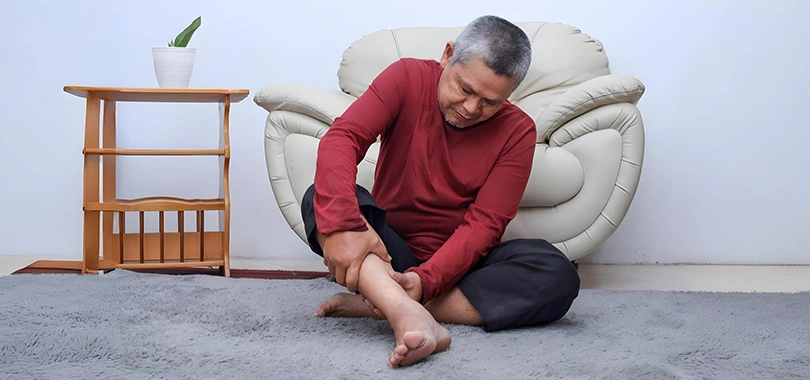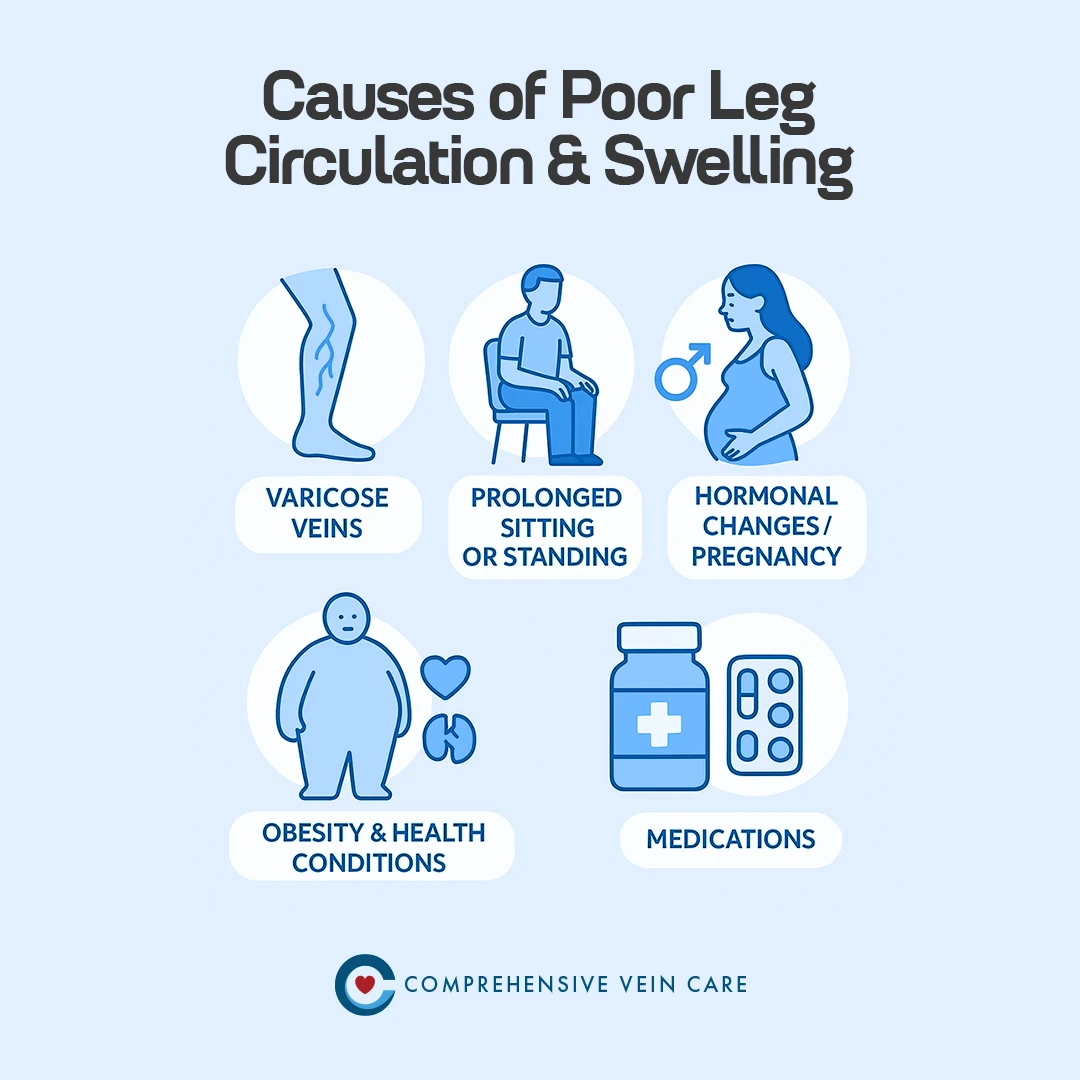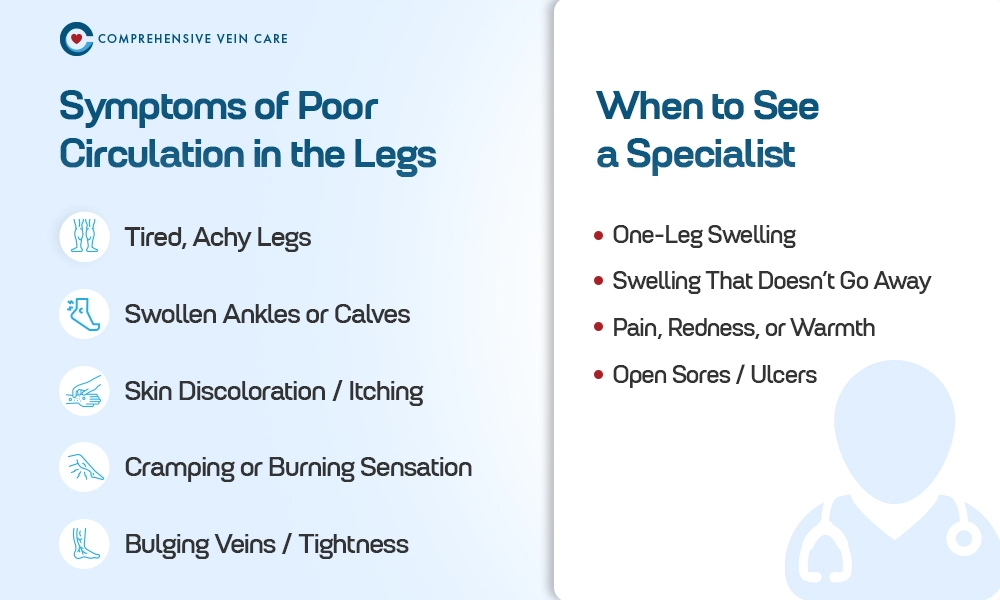Recent Blogs
- 11 Myths About Vein Treatments You Need to Know
- Causes and Treatment of Bulging Veins
- How ClosureFast Treatment Transforms Vein Health?
- How Varithena works?
- Can Dietary Modifications Play a Role in Managing or Preventing Varicose Veins?
- 8 Steps to Prep For Your First Vein Appointment
- The Benefits of Minimally Invasive Vein Treatments: What You Need to Know
- Choosing the Right Varicose Vein Doctor
- Top 10 Varicose Vein Myths-Busted!
- What’s New In The Treatment of Varicose Veins?
Published on: 02-May-2025

Many adults in the United States experience tired legs or swollen ankles at the end of the day. While it’s easy to blame fatigue or prolonged standing, these symptoms may be early indicators of an underlying vascular condition. In fact, poor blood circulation, venous insufficiency, or early-stage varicose veins often present subtly before developing into more serious issues.
Let’s explore the possible causes of persistent leg discomfort and why you shouldn’t ignore the warning signs.
When Tired Legs and Swollen Ankles Are a Concern
Feeling heaviness or puffiness in the lower limbs occasionally isn’t unusual—especially after a long day on your feet. But if symptoms persist or worsen, it could point to something more serious than everyday fatigue.
Poor venous return, which prevents blood from flowing efficiently back to the heart, is one of the primary causes of leg swelling and fatigue. This condition often leads to edema in the lower limbs, where fluid pools in the ankles and calves due to weakened or damaged veins.

What Causes Blood Circulation Problems in the Legs?
Several factors can contribute to circulatory issues and fluid retention in the legs:
- Varicose veins and venous insufficiency
Weak vein valves allow blood to flow backward and pool, leading to visible, twisted veins and leg discomfort. - Prolonged standing or sedentary lifestyle
Long hours of immobility can compromise circulation and worsen swelling. - Hormonal changes or pregnancy
These can cause increased blood volume and pressure on leg veins, triggering symptoms. - Obesity or underlying medical conditions
Conditions like heart failure, kidney disease, or lymphedema may cause persistent ankle puffiness. - Medications
Some blood pressure medications, steroids, and antidepressants can cause fluid retention in the legs.
Symptoms of Poor Circulation in the Legs
Knowing the warning signs of vascular disease can help you take action early. Look out for:
- Achy, tired legs—especially after standing all day
- Swelling around ankles or calves that doesn’t fully go away overnight
- Skin changes like discoloration, dryness, or itchiness
- Cramping or burning sensations in the lower legs
- Bulging veins or a feeling of tightness in the skin
These could all be signs of compromised blood flow, and addressing them early can prevent more severe outcomes.
When to Worry About Ankle Swelling
It’s time to consult a vein specialist if you notice:
- One leg swelling more than the other
- Persistent swelling that lasts more than a few days
- Pain, redness, or warmth near a swollen area
- Skin ulceration or open sores near the ankles
These may be early signs of vascular conditions like deep vein thrombosis (DVT) or chronic venous insufficiency (CVI), which require immediate attention.

Modern Treatment Options That Can Help
Thanks to advancements in vascular care, vein-related leg pain and swelling are highly treatable with minimally invasive procedures. At Comprehensive Vein Care, we specialize in modern therapies such as:
- Sclerotherapy – Effective for smaller varicose and spider veins
- ClosureFast – A radiofrequency-based treatment that seals faulty veins
- Varithena – A foam-based solution that improves circulation and reduces swelling
- VenaSeal – A non-thermal adhesive that closes diseased veins with minimal discomfort
These procedures are outpatient-based, require little to no downtime, and offer long-term relief from chronic symptoms.
Lifestyle Changes for Leg Pain and Circulation
In addition to clinical care, simple lifestyle adjustments can help manage symptoms.
- Elevate your legs regularly to reduce swelling
- Wear compression stockings to improve venous return
- Exercise regularly—especially walking or swimming
- Stay hydrated and reduce sodium intake
- Avoid sitting or standing in one position for too long
These changes, combined with professional care, can greatly improve your quality of life and lower your risk of developing serious vascular complications.
To better understand the types of vein treatments available and how they work, read our blog on How Sclerotherapy Works for Spider and Varicose Veins.
What Happens If You Ignore the Symptoms?
Even when symptoms like ankle swelling or tired legs seem minor, they can be early warnings of progressive venous disease. Without timely intervention, chronic venous insufficiency can lead to worsening symptoms such as skin thickening, discoloration, restless leg sensations, and even open ulcers on the lower legs. In more severe cases, blood clots can form, increasing the risk of deep vein thrombosis (DVT) or other vascular complications.
Recognizing these signs early and seeking professional evaluation is essential to avoid long-term damage and ensure proper circulation is restored.
If you're struggling with swollen legs or unexplained fatigue, don't dismiss it as just another long day. It may be your body signaling a deeper vascular issue. CVC offers personalized treatment plans using the latest in vein care technology to help restore comfort, health, and confidence—without surgery.
Book an Appointment
FAQs
1. What is the main cause of swollen ankles and tired legs?
The most common causes include poor circulation due to vein disease, long periods of standing or sitting, and fluid retention.
2. Can varicose veins cause leg fatigue and swelling?
Yes. Varicose veins are a symptom of venous insufficiency, which often results in tired, achy legs and ankle swelling.
3. When should I see a doctor about ankle swelling?
If the swelling is persistent, worsens, or comes with other symptoms like pain or skin changes, you should consult a vascular specialist.
4. Are CVC treatments painful or require long recovery?
Most treatments offered at CVC are minimally invasive, outpatient-based, and involve minimal discomfort and downtime.
5. How can I tell if my leg swelling is due to a vein problem or something else?
If swelling is accompanied by heaviness, skin changes, visible veins, or only occurs in one leg, it could be related to a vein issue. A vascular evaluation, including an ultrasound, can help determine the exact cause.
6. Can lifestyle changes alone improve venous insufficiency?
In mild cases, yes. Regular exercise, leg elevation, and wearing compression stockings can significantly reduce symptoms. However, persistent or worsening symptoms may require medical treatment.
7. Is venous insufficiency a lifelong condition?
While some cases can be managed effectively with treatment and lifestyle adjustments, chronic venous insufficiency may require ongoing care to prevent progression and maintain comfort.